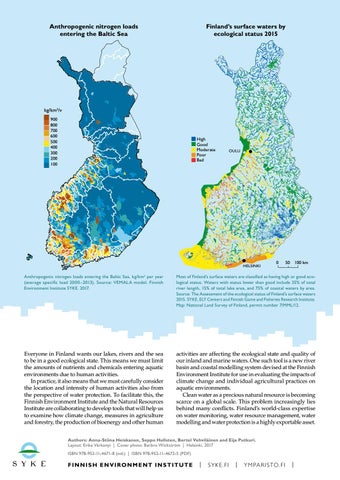Anthropogenic nitrogen loads entering the Baltic Sea
Finland’s surface waters by ecological status 2015
kg/km2/v 900 800 700 600 500 400 300 200 100
High Good Moderate Poor Bad
OULU
HELSINKI
0
50
100 km
Anthropogenic nitrogen loads entering the Baltic Sea, kg/km2 per year (average specific load 2000–2013). Source: VEMALA model. Finnish Environment Institute SYKE. 2017.
Most of Finland’s surface waters are classified as having high or good ecological status. Waters with status lower than good include 35% of total river length, 15% of total lake area, and 75% of coastal waters by area. Source: The Assessment of the ecological status of Finland’s surface waters 2015. SYKE, ELY Centers and Finnish Game and Fisheries Research Institute. Map: National Land Survey of Finland, permit number 7/MML/12.
Everyone in Finland wants our lakes, rivers and the sea to be in a good ecological state. This means we must limit the amounts of nutrients and chemicals entering aquatic environments due to human activities. In practice, it also means that we must carefully consider the location and intensity of human activities also from the perspective of water protection. To facilitate this, the Finnish Environment Institute and the Natural Resources Institute are collaborating to develop tools that will help us to examine how climate change, measures in agriculture and forestry, the production of bioenergy and other human
activities are affecting the ecological state and quality of our inland and marine waters. One such tool is a new river basin and coastal modelling system devised at the Finnish Environment Institute for use in evaluating the impacts of climate change and individual agricultural practices on aquatic environments. Clean water as a precious natural resource is becoming scarce on a global scale. This problem increasingly lies behind many conflicts. Finland’s world-class expertise on water monitoring, water resource management, water modelling and water protection is a highly exportable asset.
Authors: Anna-Stiina Heiskanen, Seppo Hellsten, Bertel Vehviläinen and Eija Putkuri. Layout: Erika Várkonyi | Cover photo: Barbro Wickström | Helsinki, 2017 ISBN 978-952-11-4671-8 (nid.) | ISBN 978-952-11-4672-5 (PDF)
F I N N I S H E N V I R O N M E N T I N S T IT U T E
|
SYKE.FI
|
Y M PA R I S TO. F I
|
